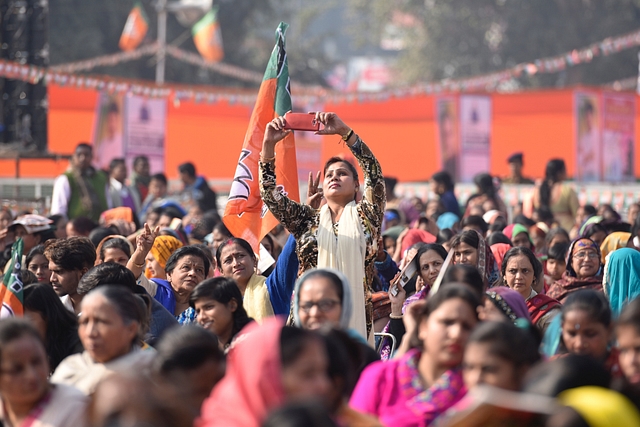
Why Women Voters Are Crucial To BJP’s 2019 Strategy
Over the last four to five years, the BJP has emerged as the first choice for most women voters. On its part, the central government too has introduced many schemes which directly benefit women.
Narendra Modi mounted a challenge to the Congress led United Progressive Alliance (UPA) government in the 2014 Lok Sabha election with a very structured campaign. His speeches had a specific build-up and a target audience, apart from careful sequencing. In the role of the defender, there has been debate on what marks the start of the 2019 Modi Lok Sabha campaign.
PM Modi addressed the Bharatiya Janata Party (BJP) Mahila Morcha convention on 22 December in Gandhinagar. While this address did not get as much attention in media or in social media, the event, perhaps, was as good a marker for the 2019 campaign launch as any.
Women have been mainstays of the BJP electoral juggernaut since 2014. Surveys have repeatedly found that women voters are disproportionately BJP-aligned. Even when the party loses – like in the three assembly elections in Chhattisgarh, Madhya Pradesh, and Rajasthan – the party was banking on the women voter surge to retain its seat tally.
There is no doubt that PM Modi has worked through his term to nurture and promote a women voter base. His important programmes have specifically targeted lifestyle improvement of Indian women.
Swachh Bharat messaging always had benefits outlined for women. Modi has stressed on the importance of having toilets in the household, linking it to the health and social dignity of women. One of the promotional campaigns for the programme which featured actress Vidya Balan had a women empowerment message asking women not to marry into households which did not have toilets.
The Jan Dhan Yojana encouraged women to get their own bank accounts and become financially independent. About 70 per cent beneficiaries of the Mudra scheme, which promotes small entrepreneurship, are women. The Sukanya Samriddhi Yojana promotes saving for the future of the girl child. It has seen more than 1 crore new account openings with Rs 20,000 crores deposited in these accounts.
The Modi government also used legislative interventions for addressing concerns of Indian women. The government passed a law awarding death penalty for rape of girl child below 12 years of age. The government is also fighting a battle to get Triple talaq outlawed from the Muslim personal laws. For this, the government used the ordinance route when it could not gather significant legislative support in the upper house of Parliament. A new law was also enacted to help working mothers get longer maternity benefits and have organised sector provide for better childcare facilities.
There have been interventions on health-related aspects too. The Matritva Vandana Yojana redefined the maternity benefits for expecting mothers, providing wage compensation during childbirth and childcare, incentives for safe delivery, and incentives for improved nutrition. Mission Indradhanush has helped immunise 80-lakh expecting women. The Poshan Abhiyan has been introduced to bring proper nutrition to expectant mothers. The sex ratio at birth has improved in 104 districts, specifically identified for better communication and policing against gender-selective abortions.
Two biggest infrastructure improvement programmes have also been targeted at the women voters. The village electrification and the subsequent household electrification programme under the Saubhagya umbrella will help improve lifestyle and increase working hours outside of home. The Ujjwala Yojana, which was launched to create a gas-based domestic economy, has since been completely reshaped to talk about the benefits accruing to women. About 8 crore households are planned to be covered under this programme, and there will, perhaps, be more scope for enhancements before the election. The PM has repeatedly said that the Ujjwala rids Indian women of inhaling smoke equivalent of hundreds of cigarettes per day as they have been traditionally using wood or kerosene as fuel sources.
In his speech at the BJP Mahila Morcha convention in Gandhinagar, PM Modi touched upon all these measures. He specifically stressed on how the government has created a provision to register houses built under the Pradhan Mantri Awas Yojana in the name of women.
The PM clearly made a comprehensive pitch to this generally loyal voter segment to continue their voting pattern. It was probably also an attempt to educate the party workers to integrate the intended benefits of these programmes in their campaign routines.
The opposition has long been aware of this specific BJP push for women votes. The past few state elections starting from Gujarat in end 2017 have all been high-pitched. These election campaigns have often been marred with acts of stray violence or aggressive tone in large, imposing gatherings. There’s a general perception that aggressive, negative election pitches put off women voters. They tend to stay in their homes on the day of the voting. Given that the BJP has lost up to 20 seats in Gujarat, Karnataka, Madhya Pradesh and Rajasthan with slim margins, this theory may well have played out.
As a defending candidate, Modi’s programmes will now align with this governance messages. He starts this process with launching new projects, highlighting cultural aspects, and dedicating infrastructure projects in Odisha and the North East region, starting 24 December. The 2019 campaign may not mirror the 2014 one, but the campaign is well and truly here.